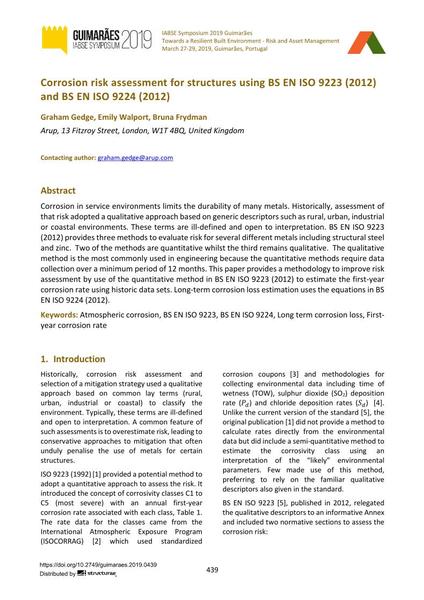Corrosion risk assessment for structures using BS EN ISO 9223 (2012) and BS EN ISO 9224 (2012)

|
|
|||||||||||
Détails bibliographiques
| Auteur(s): |
Graham Gedge
(Arup, 13 Fitzroy Street, London, W1T 4BQ, United Kingdom)
Emily Walport (Arup, 13 Fitzroy Street, London, W1T 4BQ, United Kingdom) Bruna Frydman (Arup, 13 Fitzroy Street, London, W1T 4BQ, United Kingdom) |
||||
|---|---|---|---|---|---|
| Médium: | papier de conférence | ||||
| Langue(s): | anglais | ||||
| Conférence: | IABSE Symposium: Towards a Resilient Built Environment Risk and Asset Management, Guimarães, Portugal, 27-29 March 2019 | ||||
| Publié dans: | IABSE Symposium Guimarães 2019 | ||||
|
|||||
| Page(s): | 439-446 | ||||
| Nombre total de pages (du PDF): | 8 | ||||
| DOI: | 10.2749/guimaraes.2019.0439 | ||||
| Abstrait: |
Corrosion in service environments limits the durability of many metals. Historically, assessment of that risk adopted a qualitative approach based on generic descriptors such as rural, urban, industrial or coastal environments. These terms are ill-defined and open to interpretation. BS EN ISO 9223 (2012) provides three methods to evaluate risk for several different metals including structural steel and zinc. Two of the methods are quantitative whilst the third remains qualitative. The qualitative method is the most commonly used in engineering because the quantitative methods require data collection over a minimum period of 12 months. This paper provides a methodology to improve risk assessment by use of the quantitative method in BS EN ISO 9223 (2012) to estimate the first-year corrosion rate using historic data sets. Long-term corrosion loss estimation uses the equations in BS EN ISO 9224 (2012). |
||||
